>
Aulopiformes (Grinners) >
Paraulopidae (Cucumber fishes)
Etymology: Paraulopus: Paraulopus refers to a taxon related to Aulopus, both being included in the Aulopiformes.
Environment: milieu / climate zone / depth range / distribution range
Ecologia
marino batidemersale; distribuzione batimetrica 322 - 375 m (Ref. 49923). Deep-water
Northwest Pacific: Kyushu-Palau Ridge and the Emperor Seamounts.
Size / Peso / Age
Maturity: Lm ? range ? - ? cm
Max length : 12.5 cm SL maschio/sesso non determinato; (Ref. 49923)
Short description
Chiavi di identificazione | Morfologia | Morfometria
Spine dorsali (totale) : 0; Raggi dorsali molli (totale) : 11; Spine anali: 0; Raggi anali molli: 8 - 10; Vertebre: 42 - 44. Second and third dorsal fin rays very elongated, prolonged filamentously, extending when depressed well beyond adipose fin in males, not quite reaching adipose fin in females (Ref. 49923). Sexually dimorphic in dorsal and caudal fin coloration: dorsal fin with a black upper margin broader in males than in females; caudal fin white with a black posterior margin on each lobe in males, black margin absent in females (Ref. 49923).
Life cycle and mating behavior
Maturità | Riproduzione | Deposizione | Uova | Fecundity | Larve
Sato, T. and T. Nakabo, 2003. A revision of the Paraulopus oblongus group (Aulopiformes: Paraulopidae) with description of a new species. Ichthyol. Res. 50(2):164-177. (Ref. 49923)
IUCN Red List Status (Ref. 130435: Version 2024-1)
Threat to humans
Harmless
Human uses
Strumenti
Special reports
Download XML
Fonti Internet
Estimates based on models
Phylogenetic diversity index (Ref.
82804): PD
50 = 0.5001 [Uniqueness, from 0.5 = low to 2.0 = high].
Bayesian length-weight: a=0.00389 (0.00180 - 0.00842), b=3.12 (2.94 - 3.30), in cm total length, based on all LWR estimates for this body shape (Ref.
93245).
Trophic level (Ref.
69278): 3.8 ±0.7 se; based on size and trophs of closest relatives
Fishing Vulnerability (Ref.
59153): Low vulnerability (10 of 100).
